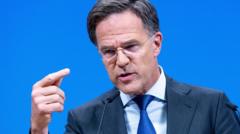In a move likely to reshape the future of military funding, NATO Secretary General Mark Rutte announced a proposal for member countries to allocate 5% of their GDP towards defense spending. This aim, echoed by former President Donald Trump, is a significant enhancement from the current 2% benchmark that many European nations have struggled to meet. Rutte's proposal, unveiled during a press conference in Brussels, seeks to avoid a repeat of the 2016 debacle, where Trump criticized European allies for insufficient military contributions.
NATO Chief Proposes Ambitious 5% Defense Spending Plan Ahead of Summit

NATO Chief Proposes Ambitious 5% Defense Spending Plan Ahead of Summit
As NATO prepares for its upcoming summit, Secretary General Mark Rutte aims to create a favorable outcome for Donald Trump by pushing for increased defense spending.
To ease the transition, Rutte's plan would require nations to gradually increase core defense expenditures to 3.5%, with the remaining 1.5% sourced from "defense-related expenditures," a term that theoretically allows for more flexibility in budgeting. Rutte highlighted that even the US, which currently spends about 3.4% of its GDP on defense, would endorse this new target, easing any burden on American taxpayers.
Despite optimism surrounding the proposal, the real challenge lies in ensuring compliance. Leaders are expected to agree on this ambitious target at the summit in The Hague, but timeframes remain blurry, with some estimates suggesting a compliance deadline around a decade away. Moreover, historical precedents indicate that NATO lacks tangible sanctions for nations that fail to meet existing spending targets.
Amidst these discussions, US Defense Secretary Pete Hegseth pointed out that several countries, including France, Germany, and Poland, are already signaling intention to adhere to the 5% defense spending goal. However, Hegseth did not specify which nations had not committed, though he expressed confidence in the UK's participation.
As NATO officials gear up for pivotal discussions, the success of this proposal could redefine the alliance’s military spending landscape and influence transatlantic relations for years to come.
Despite optimism surrounding the proposal, the real challenge lies in ensuring compliance. Leaders are expected to agree on this ambitious target at the summit in The Hague, but timeframes remain blurry, with some estimates suggesting a compliance deadline around a decade away. Moreover, historical precedents indicate that NATO lacks tangible sanctions for nations that fail to meet existing spending targets.
Amidst these discussions, US Defense Secretary Pete Hegseth pointed out that several countries, including France, Germany, and Poland, are already signaling intention to adhere to the 5% defense spending goal. However, Hegseth did not specify which nations had not committed, though he expressed confidence in the UK's participation.
As NATO officials gear up for pivotal discussions, the success of this proposal could redefine the alliance’s military spending landscape and influence transatlantic relations for years to come.




















